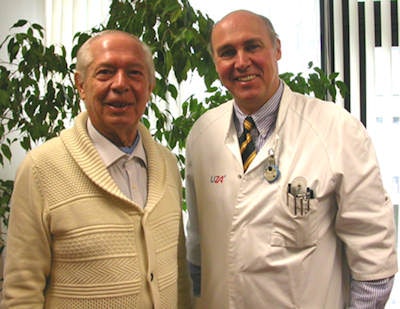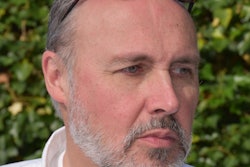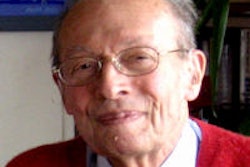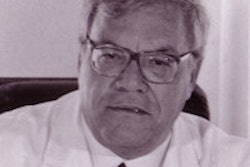
Dr. Arthur M. De Schepper, PhD, who died on 4 October, will be remembered as a greatly admired and internationally respected radiologist, with an almost superhuman dedication to his work. His unrelenting energy and intellectual curiosity are evident from his prolific scientific output. His groundbreaking work on soft-tissue tumors made him a world authority on this topic.
Dr. De Schepper served as president of the Royal Belgian Society of Radiology (RBRS) and of the Antwerp Medical Days; he also held many other functions during his prestigious career. But perhaps most of all, he will be remembered for creating the "Antwerp school of radiology," a breeding ground of young radiologists, many of whom have gone on to occupy positions of responsibility in the field of radiology in Belgium and beyond.
 Arthur De Schepper built from scratch a new imaging department at Antwerp University Hospital.
Arthur De Schepper built from scratch a new imaging department at Antwerp University Hospital.
Our first meeting with Arthur was a memorable one. He was a dashing, young assistant professor of radiology at the University of Antwerp, full of energy and new ideas, and he was teaching an introductory radiology course to medical students. All of us were fascinated by the inner world of the human body, which became visible through radiological techniques.
The year was 1978. Radiology was completely different from what it is now. CT was still in its infancy, and in Belgium there were at that time only two CT units. Ultrasound was a cumbersome technique, producing grainy images, and MRI was nonexistent. The course focused mainly on conventional radiological techniques, but Arthur introduced a clinical symptom-based approach to radiology, an algorithmic approach avant la lettre. In this way, we learned about the patient with right lower quadrant pain, the woman with a lump in the breast, a man with low back pain, etc. As medical students, we loved his classes, and -- unlike those of some of his colleagues -- they were very well attended.
Arthur grew up in Boom, an industrial town south of Antwerp. He completed his medical training at the Catholic University of Leuven and graduated in 1963 as a Doctor in Medicine, Surgery, and Obstetrics, as an MD was called in those days. He started his radiology residency at Stuivenberg General Hospital under the tutorship of Dr. Charles Dochez, who would become a lifelong friend.
His main interest was angiography. The Seldinger technique for arterial catherization had been introduced barely a decade earlier, in 1953, by the Swedish radiologist Sven-Ivar Seldinger. Arthur refined his angiography training in the department of Dr. C. Hernandez, at the Hôtel-Dieu Hospital in Paris. After his return to Antwerp, he became chair of radiology at Stuivenberg General Hospital in 1973. Five years later, he was appointed coordinating chairman of the Public Assistance hospitals of the City of Antwerp.
During the 1970s, he continued to perform angiography and publish scientific reports about this new technique. His 1972 article, "Nutcracker phenomenon of the renal vein causing left renal vein pathology" in the Belgian Journal of Radiology (JBR-BTR), remains a classic. His scientific output culminated in the successful public defense in 1976 of his PhD thesis on the ovarian vein syndrome.
Arthur's medical and scientific achievements and successes did not go unnoticed. His appointment in 1978 as assistant professor of radiology at the University of Antwerp came as no surprise. He would become the teacher and mentor of several generations of medical students. At the inauguration of Antwerp University Hospital in 1980, he became chairman of the department of radiology. He faced major challenges building from scratch a new imaging department, selecting capable and dedicated collaborators, and developing a structure for teaching residents and students.
These were exhilarating times, as everything was new and exciting. Arthur's success in creating a productive and special ambiance in the department of radiology was the result of an intense dedication, true feelings of friendship for his collaborators regardless of their degree or function, critical discussion, and intellectual honesty. He had an uncanny ability to attract students and collaborators of great talent and commitment, and he was able to convey to them his energy and enthusiasm.
 Between 1980 and his retirement in 2003, Arthur De Schepper trained more than 80 radiologists, including Paul Parizel (right), the current chair of radiology.
Between 1980 and his retirement in 2003, Arthur De Schepper trained more than 80 radiologists, including Paul Parizel (right), the current chair of radiology.Between 1980 and his retirement in 2003, Arthur trained more than 80 radiologists. Together with staff, nurses, technologists, and other collaborators of the department, they constituted his extended family. His energy and vision resulted in a prolific scientific output. When he retired in 2003, he had authored, or co-authored, more than 250 scientific papers, referenced in PubMed.
At the beginning of his career, his interest converged mainly on vascular radiology and angiographic techniques. He was the first to perform percutaneous angioplasty of the renal artery in Antwerp. With the advent of CT and MRI, he transformed himself into an expert of cross-sectional imaging techniques. In 1986, Antwerp University Hospital was the first academic teaching hospital in Flanders to install a superconducting MRI unit.
From the early 1990s onward, Arthur developed a keen interest in imaging of bone and soft-tissue tumors. He created the Belgian Soft Tissue Neoplasm Registry (BSTNR), which provided second opinions to radiologists and other medical specialists from all over the country.
His expertise and the BSTNR database led to the publication in 1997 of a very successful textbook Imaging of Soft Tumors. A second edition was published in 2001, and a completely revised edition appeared in 2006. The book was also translated into Chinese. Before that, he had already published a monograph on medical imaging of the spleen (2000).
After his retirement as chairman of the department in 2003, he remained very active as an expert and provided hundreds of second opinions in medicolegal cases. Because of Arthur's expertise and knowledge, Dr. Hans Bloem invited him to become a consultant professor of radiology at Leiden University Medical Center in the Netherlands. He went on working with more energy and enthusiasm than most people half his age, and this kept his body young and his mind alert.
He was invited to present guest lectures at the European Congress of Radiology (ECR), European Society of Skeletal Radiology (ESSR), Radiological Society of North America (RSNA), and many other major international meetings. Moreover, he had a strong interest in educational activities in radiology, on a local, national and international level, such as his legendary evening meetings "Radiologisch Uur van het UZA."
While his medical, scientific, and educational achievements were widely known and appreciated, Arthur had human and humane qualities only his family and close friends were allowed to fully appreciate. He was the loving husband of Anya Augustynen, the proud father of 12 children and the "papie" of 21 grandchildren. His love for them all, as well as the little things in life, the birds in his garden, his walks in the woods, and wanderings through the mysterious little alleys of Antwerp, all crystallized into hundreds of poems.
In November 2011, Arthur suddenly found himself at the other side of the divide when vague abdominal complaints proved to be symptoms of metastatic colon cancer. With admirable courage, he accepted the diagnosis and its consequences. He never tried to dissimulate the seriousness of his condition, and at the same time went on working and helping his colleagues as much as physically possible.
On 11 September 2013, at a symposium to celebrate the 10th anniversary of his retirement, he gave his last lecture at the University of Antwerp: an overview of his long career and a lucid summary of what had been and what was to come. Less than four weeks later, he left us with a last poem:
To whom it may concern
bury me cautiously
with a bunch of lavender
and pen and paper
one never knows
my soul might write
the timeless poem
I never could alive
forget pomp and circumstance
sprinkle humor in my grave
and a piece of the rainbow
one never knows
my eye might see
a spray of colors
I never could alive
don't bury me loud
put grains of silence in my grave
and an ivory music box
one never knows
there is no heavenly music
but sounds I will hear
I hardly could alive
leave home your funeral wreaths
your elegies and lament
as for an honorable man
put cuddles and caresses in my grave
one never knows
our love survives
We are grateful for the support, warmth, and friendship that Arthur bestowed upon us throughout his long and illustrious career. He will live on in our hearts and minds as a leader in radiology, but even more so as our friend, "our" professor.
Dr. Paul M. Parizel, PhD, is professor and chair in the department of radiology at Antwerp University Hospital, and Dr. Jan M.L. Bosmans, PhD, is a staff radiologist at Ghent University Hospital, both in Belgium.
The comments and observations expressed herein do not necessarily reflect the opinions of AuntMinnieEurope.com, nor should they be construed as an endorsement or admonishment of any particular vendor, analyst, industry consultant, or consulting group.



















